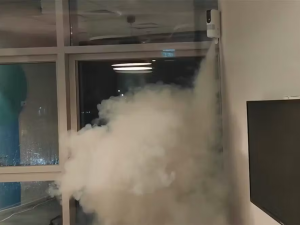Drones, robots, artificial intelligence, facial recognition, UAS detection systems…the list goes on. The exponential growth in technology brings new advancements that allow the previously unachievable to be attainable; however, many of these new technologies are slow to be embraced by end-users and integrators.
Why is the security industry so fearful of intrepidly moving forward and embracing these new technologies to enhance the overall effectiveness of their – or their customers’ – protection programs?
Common Barriers to Entry
In working with many end-users over the years, I have seen numerous, consistent, and repeating barriers to entry in adopting and embracing emerging technology. Often these barriers to entry are largely centered on leaving a comfort zone of the known for the unknown.
Let’s explore four of the key barriers to entry for end-users considering new and emerging technology:
Cutting edge vs. bleeding edge: Being an early adopter can be appealing – you are first in line to grab up the latest technology. Unfortunately, many times as new technology is first rolled out, it comes with a host of complexities in getting it to operate as intended. This is where the cutting edge turns into the bleeding edge – when the new technology causes the user, integrator and everyone involved in the rollout of the technology a painful go at getting it right.
In the meantime, someone needs to answer to the person in the organization who is paying the bills as to why this technology is not performing as expected – making the venture of becoming an early adopter painful, expensive, and potentially embarrassing.
How do you avoid this type of blunder in being an early adopter? You could, of course, wait until the manufacturer of the technology has taken their lumps from other early adopters. A better practice would be to think ahead of the curve using a lab environment to bench test any new technology before it gets introduced to you or your customer’s systems in an active capacity.
Have a rollback strategy vetted to ensure you have a path to return to a previous system configuration should your technology rollout go wrong. These best practices are valid for both emerging technology or simply adding new technology to your organization.
Leadership buy-in: Often, if leadership cannot see the direct correlation to saving time or money, it is a harder sell to get new and emerging technology embraced and funded. Sometimes the reverse is true, where leadership is introduced to a shiny new thing, and they want it – now!
Because of the urgency, it is everyone else’s task to make it happen.
How do you make the business case for a new technology? It is all in the numbers. In evaluating technology, most all technology is designed to do something better, faster, smarter, etc., and that gets expressed by two key factors: time and money. When making the case for new technology, detailing the short- and long-term savings in capital and operational expenses, as well as the human capital savings for adding technology, should enable end-users to express the return on investment. This is the key selling factor to obtaining leadership buy-in, and it is something integrators should be helping their clients to achieve.
Regulatory factors: Having new technology that can solve a problem for a regulated industry may have the customers lined up at an integrator’s door with interest, but they may be hesitant to make the purchase until the “powers that be” chime in with direction or approval.
For example, in the airport vertical, many new technologies that can work well in the airport environment take considerable time for the solution to be evaluated by the FAA and the National Safe Skies Alliance. Most airports will wait for this evaluation before it is is willing to dedicate the funding required to implement the solution.
In the regulated environment, there is not much workaround to this process; thus, it is best to set new and emerging technology up for early review. In some cases, the customer can serve as a test bed if they are willing.
Skepticism: The product always looks good on the trade show floor, but will it perform in the real world? Salespeople are great at pitching the promise, but battle-hardened security professionals know that big promises can come with big disappointments.
Unfortunately, those disappointments can tarnish good reputations. For that reason, seasoned security professionals are far more likely to shy away from technology that has not been vetted by peers and endorsed by other reputable firms and manufacturers.
To avoid the “cold shoulder” when introducing new and emerging technology to customers, it is best to know your facts about the product. Explain how it has been proven in the marketplace and what guarantees the manufacturer and supplier are willing to make behind its successful deployment. If you are truly confident in how the technology will perform, base your payment structure on the technology’s successful deployment and performance.
Take the risk off the customer. If the technology does not perform, remove it at no cost. If it works successfully, the customer pays a 10% premium – a win/win.
Keep Pedaling
Overall, removing the barriers to entry on new and emerging technology falls on the manufacturer. The end-user wants to know they will not end up spending money on something that does not perform, has a costly and frustrating implementation, and creates a generally embarrassing situation professionally that needs to be explained to leadership.
In the meantime, manufacturers should keep bringing those solutions to market and integrators and consultants should be making the case for their successful implementation.
Article Link – https://www.securityinfowatch.com/integrators/article/21290827/tech-trends-overcoming-barriers-to-entry
This article originally appeared in the January 2023 issue of Security Business magazine. Paul F Benne is the President of Sentinel Consulting and has over 35 years in the protective service industry.







